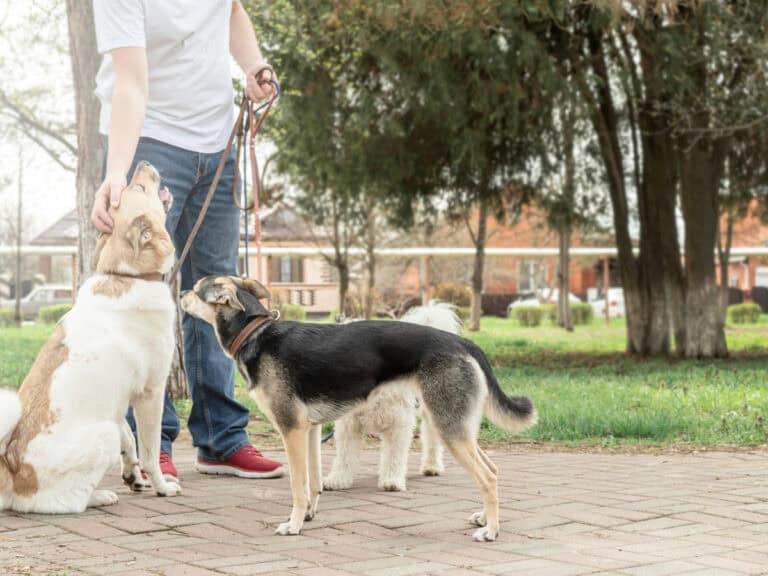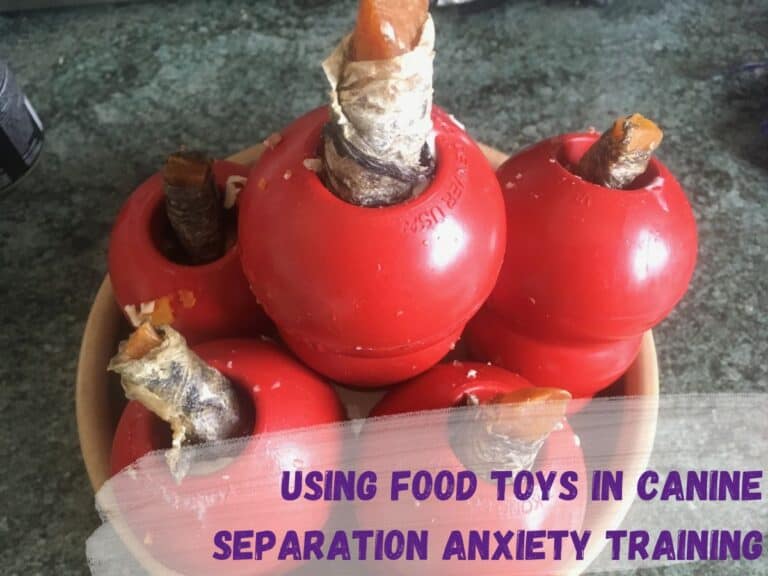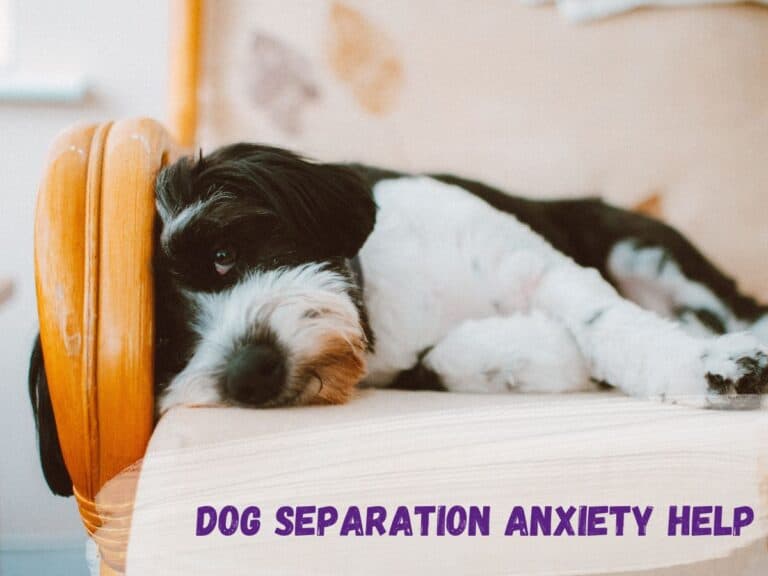Dog Separation Anxiety Medication
The Pet Coach features affiliate links and participates in the Amazon Services LLC Associates Program. If you choose to make a purchase through one of these Amazon links, I may earn a small commission—at no additional cost to you. These affiliate earnings help support the website and allow me to continue providing free content for pet parents. For more details, please see my disclosure policy.
If you're grappling with your dog's separation anxiety, you're not alone. Separation anxiety medication can be a game-changer in helping to manage what is a distressing condition, for your dog who is struggling, but also for you who is having to figure out what to do when you can't leave your dog!
Medication offers relief for both you and your dog, in creating a greater window of learning so that they are more reception to behaviour modifcation and departure training. But before you rush to the vet, it's crucial to understand the different options available and how they work. From prescription only drugs to natural or complementary alternatives, the world of canine anxiety medication is vast and complex. You'll need to weigh the benefits against potential side effects and consider how to integrate medication with behavioural strategies. Ready to explore the path to a calmer, happier pup?
In this article, I'll give you a brief overview of what separation anxiety is, go through the different types of anxiety medications available. talk about medications licensed for dogs, and those that aren't, as well go through what the differences are between long term and situational separation anxiety medication. I'll also go into what in my opinion works best separation anxiety medication WITH behaviour modification.
Please note: I am a certified separation anxiety trainer (CSAT), and a COAPE Qualified Companion Animal Behaviourist (CAB), and have worked in the industry for more than 15 years, however I am not a Vet and cannot legally recommend a type of drug to use for your individual dog, these opinions are my own, and are to give you a better understanding.
To learn more about me, check out the about me, or get in touch to tell me about your dog and book a consult. Think there is something wrong with this article? Definitely get in touch, I am all ears!

Understanding Canine Separation Anxiety
It's a distressing reality for many dog owners: their beloved pet becomes anxious, destructive, or vocal when left alone. This condition, known as canine separation anxiety, affects a significant portion of dogs, with estimates ranging from 14% to up to 76% of the canine population!
Signs of separation anxiety include excessive whining or barking, indoor urination or defecation, and destructive chewing or digging when your dog is left by themselves.
If you're dealing with this issue, it's crucial to understand that it's a complex behavioural problem requiring a multifaceted approach. Treatment typically involves behavioural modification techniques, like gradual desensitisation to alone time, combined with environmental enrichment, and ensuring your dog's biological and emotional needs are met.
This can include providing interactive toys and ensuring regular exercise to reduce boredom and anxiety levels, as well as not exposing your dog to being along longer then they can handle.
In many cases, your veterinarian may recommend medications such as SSRIs or anxiolytics to complement behavioural interventions.
Learn more in our full guide to dog separation anxiety help.

Types of Anxiety Medications
Several types of anxiety medications can be used to treat canine separation anxiety, each with its own mechanism of action and potential benefits.
Selective serotonin reuptake inhibitors (SSRIs) are often the first-line treatment, with Fluoxetine branded as Reconcile being approved for dogs. These medications work by increasing serotonin levels in the brain, potentially reducing anxiety symptoms.
Tricyclic antidepressants (TCAs), such as clomipramine brand as Clomicalm, offer an alternative, and have been around a long time. Prior to Reconcile being licesed to use with dogs, Vets would commonly prescribe Clomicalm for dogs with separation anxiety.
Anxiolytic agents, including benzodiazepines, aren't recommended as primary treatments due to potential dependence and withdrawal issues. Another important thing to note is that they commonly cause anterograde amnesia, this is where you will struggle to learn nerw things, or form new memories, which isn't ideal when you're trying to teach a dog something!
For managing somatic symptoms, beta-adrenergic blocking agents like propranolol may be considered. However, they're contraindicated in dogs with asthma and require careful monitoring.
Short-term relief may be achieved with antihistamines like hydroxyzine or Benadryl, due to their sedating effects, though their long-term efficacy for separation anxiety is unproven.
When selecting a medication, you'll need to consider your dog's specific symptoms, potential side effects, and the medication's duration of action.
Always consult with a veterinarian to determine the most appropriate treatment plan, as combining medication with behavior modification often yields the best results.

Approved Medications for Dogs With Separation Anxiety
While various medications can be prescribed off-label for canine anxiety, there are specifically approved certain drugs for treating separation anxiety in dogs. These medications are tried and tested, and provide a reliable foundation for veterinarians to address this all to common behaviour problem.
Fluoxetine branded as Reconcile, an SSRI, stands out as one of the Vet approved options. It works by increasing serotonin levels in your dog's brain, helping to alleviate anxiety symptoms. You'll need to work closely with your vet to determine the appropriate dosage based on your dog's weight and specific needs.
Another approved medication is clomipramine branded as Clomicalm, a TCA, tricyclic antidepressant. This drug has demonstrated effectiveness in reducing anxiety-related behaviors, particularly those associated with separation anxiety. Like Reconcile, the dosage must be carefully tailored to your dog's individual requirements.
It's crucial to understand that these medications aren't standalone solutions. Your veterinarian will likely recommend combining pharmaceutical treatment with behavioral modification strategies such as working with a CSAT, to maximise effectiveness.
This comprehensive approach addresses both the physiological and psychological aspects of your dog's anxiety, offering the best chance for successful management of separation anxiety.

Off-Label Medication Options
Although Veterinary approved medications should be the first port of call for prescribing according to the Veterinary cascade, veterinarians sometimes prescribe off-label options to address individual needs*. These alternatives can provide tailored solutions for dogs that don't respond well to standard treatments.
Tricyclic antidepressants (TCAs) like imipramine, while FDA-approved for panic disorders in humans, can be effective for canine separation anxiety. They work by targeting multiple neurotransmitters, potentially offering broader symptom relief.
Similarly, selective serotonin reuptake inhibitors (SSRIs) such as sertraline may be prescribed off-label, leveraging their anxiety-reducing properties observed in human patients.
Trazodone is an antidepressant medication that is sometimes prescribed off-label for dogs suffering from separation anxiety. It belongs to a class of drugs called serotonin antagonists and reuptake inhibitors (SARIs).
For dogs with physical manifestations of anxiety, beta-blockers like propranolol can help alleviate symptoms such as rapid heartbeat or trembling, by reducing the physical feeling of panic, we can also help with reducing the mental feeling. However, you'll need to closely monitor your dog for side effects.
Buspirone, an anxiolytic agent, offers another off-label option, though it's typically reserved for adult dogs due to concerns about dependence.
In some cases, your veterinarian might consider gabapentin, an anticonvulsant with anxiolytic effects. While not approved for anxiety in dogs, it can be beneficial in certain situations.
Always discuss the potential risks and benefits of off-label medications with your Vet to ensure the best choice for your dog's specific needs.
*Side note: The rules on prescribing off label have been tightened up in the UK Royal Veterinary College. See this Vet Times article for the latest info

Situational Vs Long-Term Medication
When it comes to medications for separation anxiety in dogs, there's a clear distinction between situational and long-term medications.
Long term approaches tend to be drugs like Reconcile and Clomicalm, these mood stabilisers take at least a couple of weeks, and often 6 or more in my experience, to really see full effects in the dog.
Situational medication for separation anxiety, tend to be drugs that you use when there is no other option but you have to go out.
Commonly use situational drugs for separation anxiety are:
Clondine – Often used for its calming effects, it can help manage anxiety during stressful situations.
Trazodone – Frequently prescribed for its sedative properties, trazodone can be used when a dog is expected to experience anxiety, such as during long departures or chaotic situations.
Benzodiazepines – This class includes medications like Alprazolam (commonly known as Xanax) and Lorazepam (brand name Ativan). They are effective for moderate to severe situational anxiety and should be administered prior to the anxiety-inducing event. As mentioned previously these drugs do cause problems with memory retention.

Short Term Vs Long Term Treatment for Separation Anxiety
Short-term treatment often involves medications like SSRIs, which can provide quick relief from acute symptoms within a few weeks or months. This rapid intervention can be crucial for managing severe cases and improving your dog's immediate quality of life.
Long-term treatment, however, focuses on sustainable solutions, that change how the dog actually feels about being left, this typically involves looking at the emotions behind what is driving the behaviour.
As a CSAT and qualified dog behaviourist I also work to help your dog develop adaptive coping mechanisms and reduce anxiety over time.
For many complex cases, you will need to combine medication with behaviour modification to get the best results. The medication gives us that bigger window of learning, the desensitisation makes your dog feel less sensitive about being left, the MHERA work helps us elevate your dog's overall mood state, so that they are receptive to behavioural intervention and have a more optimistic outlook day to day.
While medications offer fast relief, they can of course come with potential side effects and the risk of dependence. You'll need to monitor your dog closely and work with your vet to taper off medications as long-term goals are met.
Remember, early intervention is key. By addressing separation anxiety promptly with an appropriate treatment plan, you'll significantly improve your dog's chances of overcoming this condition.
With consistent support and management, many dogs can learn to cope with separation anxiety effectively.
Potential Side Effects
As you consider medication options for your dog's separation anxiety, it's important to understand the potential side effects. Selective serotonin reuptake inhibitors (SSRIs), commonly prescribed for this condition, can cause drowsiness, nausea, headache, insomnia, and decreased appetite. Be prepared to monitor your dog closely for these effects.
It's worth remembering that although there may be side effects, these often wear off, and long term at least your sog is no longer having panic attacks!
Specific medications have varying response rates and side effect profiles. this is just one reason that it is crucial to work closely with your Vet and behaviourist to monitor your dog's response to medication and adjust as needed.

Combining Medication With Behaviour Modification
Combining medication with behavior modification techniques creates a powerful approach to treating your dog's separation anxiety. This dual strategy addresses both the biological and psychological aspects of your pet's condition, often leading to enhanced treatment outcomes.
By pairing medications like SSRIs with Behavioral Therapy techniques, you're tackling the problem from multiple angles. Gradual exposure, and desensitisation complements medication effects by systematically reducing your dog's reaction to being left, really we want tjhem to just feel kinda bored when you go! This allows your dog to face separation situations more comfortably, reinforcing the calming effects of the medication.
You'll need to consistently monitor your dog's progress and medication effects to optimise the treatment plan, and I'd always recommend working with a behaviourist on this.
I hope that's given you an insight into medication options for your dog's separation anxiety. Remember, while drugs like fluoxetine and clomipramine can provide quick relief, they're most effective when combined with behaviour modification.
Don't forget to monitor for side effects and adjust dosages as needed. Involve your family in the treatment process to create a supportive environment. With patience and consistency, you'll help your furry friend overcome their anxiety and enjoy a happier, more relaxed life.
To learn more about dog separation anxiety, check out my article on why we don't use food in separation anxiety, learn about the best cameras for dog separation anxiety or book a call to discuss your dog's issues with me.






